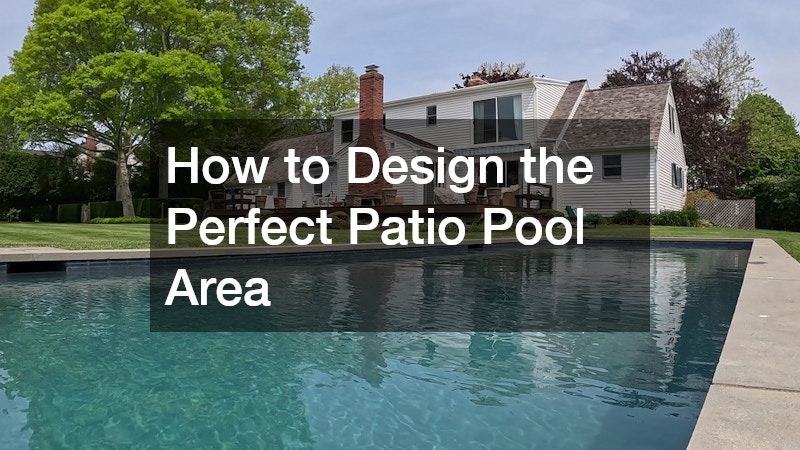
Creating a functional and aesthetically pleasing patio pool area can transform your outdoor space into a personal oasis. This guide will walk you through the process of designing your dream pool area, ensuring that you can enjoy the sun, water, and ambiance right at home. With careful planning and thoughtful choices, your patio pool can be the envy of your neighborhood, providing both beauty and practicality.
Video Source
The first step in designing the perfect patio pool area is strategic planning. Consider your available space and how you wish to use it, taking into account your lifestyle and the size of your family. Will your pool primarily be used for exercise, entertainment, or relaxation? Answering these questions will help determine the ideal dimensions and layout of your pool. Remember to account for poolside furniture, walkways, and additional features like a jacuzzi or outdoor kitchen in your overall design.
Next, think about the climate in your region. If you live in an area with a lot of sun, consider installing a shade structure, like a pergola, to make your patio pool area comfortable all year long. Cold climates may require considerations for pool heating systems or solar covers to extend your swimming season. These climate-related decisions will impact not only the usability of your pool but also your budget, so careful planning is crucial. Ensuring these aspects are accounted for will help create a space that you can enjoy in various weather conditions.
The choice of materials for your patio pool area is critical for both durability and style. When choosing decking or patio materials, prioritize non-slip surfaces to prevent accidents, especially when the deck is wet. Popular options include textured concrete, pavers, or composite decking, each offering various aesthetic and functional benefits. For a natural look, stone or tile can add elegance, provided they are rated for outdoor use and are resistant to seasonal weather changes. The right materials can enhance the longevity and safety of your pool area.
Another important consideration is the maintenance of these materials. While elegant, wood decking can be high maintenance, requiring regular sealing and treatment against moisture and sun damage. In contrast, composite materials are typically lower maintenance but can be more expensive upfront. Understanding the long-term care requirements of your selected materials will ensure your patio pool remains looking fresh and inviting year after year. Balancing initial costs with maintenance needs is critical for a sustainable design.
Design features can elevate the functionality and aesthetics of your patio pool area. Incorporating a variety of seating options can cater to different activities, from lounging to dining. Thoughtfully placed loungers and deck chairs provide spots for relaxation, while a dining set can host meals and gatherings poolside. For additional luxury, you might consider adding a hot tub or a fire pit, creating warmth and ambiance for evening use. These features not only enhance your space but also ensure diverse and memorable outdoor experiences.
Incorporating water features like fountains or waterfalls can also add a dynamic element to your patio pool area. The soothing sounds of cascading water not only enhance the atmosphere but can also promote relaxation and tranquility. Beyond being an auditory delight, visually, these features create a focal point, transforming your pool area into a more sophisticated space. Simple additions like a waterfall wall or bubbling fountain can dramatically impact the overall aesthetics of your space. Such elements can be incorporated regardless of your budget or space constraints.
Once your patio pool area design is complete, adding personal touches can make the space uniquely yours. Consider incorporating potted plants or vertical gardens to introduce greenery and soften the hardscape. Outdoor rugs or throw pillows can add pops of color and comfort to your seating areas, allowing for seasonal refreshes. These elements not only infuse personality but also add layers to the visual depth of your space. Small details like decorative lanterns or sculptures can enhance the atmosphere, creating a welcoming and cozy ambiance.
While enjoying your new patio pool area is the ultimate goal, maintaining it is necessary to prolong its life and beauty. Regular cleaning of the pool and surrounding areas prevents dirt and algae buildup, keeping the space fresh and inviting. Schedule routine inspections for pool equipment and repair any damages to decking or furniture swiftly to prevent further problems. Implementing a maintenance routine, while initially time-consuming, will ensure your space remains an oasis for years to come. Proper care and upkeep guarantee enduring functionality and visual appeal.
In conclusion, designing the perfect patio pool area involves combining functionality with aesthetics to create a space that reflects your lifestyle and meets your needs. From initial planning to the selection of materials and design features, each stage is crucial in achieving a harmonious and delightful outdoor environment. With patience, creativity, and attention to detail, your patio pool can become a cherished part of your home for enjoyment alone or with family and friends. Remember, the ultimate goal is a beautiful, functional, and lasting addition to your outdoor living space.
